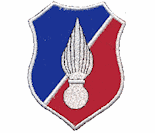Gendarmerie Nationale
 After the Belgian revolution of 1830 the determination of the power relationship between central and local government became one of the most important and controversial political questions in the country. Many developed close camaraderie during their service in the Civil Guard. The guard was established at the time of independence, in 1830, and continued as the internal security militia until 1921, when it was replaced by the modern gendarmerie. In the 1980s some elderly Belgians still recalled the plumed helmets and ornate uniforms that were worn by the guards during parades and other ceremonies. The working class, however, had little sympathy for the Civil Guard because it was frequently required to suppress workers' demonstrations for higher pay and improved working conditions.
After the Belgian revolution of 1830 the determination of the power relationship between central and local government became one of the most important and controversial political questions in the country. Many developed close camaraderie during their service in the Civil Guard. The guard was established at the time of independence, in 1830, and continued as the internal security militia until 1921, when it was replaced by the modern gendarmerie. In the 1980s some elderly Belgians still recalled the plumed helmets and ornate uniforms that were worn by the guards during parades and other ceremonies. The working class, however, had little sympathy for the Civil Guard because it was frequently required to suppress workers' demonstrations for higher pay and improved working conditions.
The concentration of power in the central government became decisive after World War II. The organization and development of the Belgian police system reflected this trend. "La Gendarmerie Nationale" had become the most powerful and best equipped police organization in the country. It was believed that this trend toward the centralization of power in the gendarmerie was due to several factors: the lack of an operational conception of local autonomy in traditional Belgian political circles; and the menace of public disorder from ongoing hostilities between various groups in the country.
On May 23, 1998, eight Democratic parties concluded the "octopus" agreement, sealing the reform of police services. This agreement was n translated in the Act of 7 December 1998, organizing a police service integrated, structured on two levels. This substituted a new police organization on two levels of police: the Federal and local level, for the traditional police services: the gendarmerie, communal police and judicial police près les parquets. These two levels are autonomous and under the control of separate authorities. The goal is a nearest police citizens and its expectations, working in a manner that is complementary, integrated. Now all members of the two levels of police personnel are subject to the same status.
The federal police has existed since 1 January 2001. It provides the function of specialized police and supralocal missions and support to the local police. It includes both the operational services (road, navigation, judicial police police police, etc.) and administrative services (human resources management, facilities management, etc.). Local police performs functions such as the work of district police, the home, the intervention, police assistance to victims, the local search and the maintenance of public order. Local police and federal police together provide integrated police function. They are complementary and work closely together to contribute to greater safety in the country and to ensure democracy.
 Three kinds of police existed in Belgium — the gendarmerie, the Criminal Police, and a number of commune police forces. There also exists a parish constable system in the rural areas. The gendarmerie was one of the armed forces of Belgium but was not part of the army. Apart from having a general headquarters and a training school, it was organized into territorial groups, mobile groups, and criminal investigation detachments. Its main functions were the investigation of crimes, the escorting of prisoners, preventive police work, the restoration and maintenance of public order, the enforcement of traffic laws, and military police duties. Although the gendarmerie had jurisdiction over the entire country, it normally operated only in those areas outside the jurisdiction of a municipal police force.
Three kinds of police existed in Belgium — the gendarmerie, the Criminal Police, and a number of commune police forces. There also exists a parish constable system in the rural areas. The gendarmerie was one of the armed forces of Belgium but was not part of the army. Apart from having a general headquarters and a training school, it was organized into territorial groups, mobile groups, and criminal investigation detachments. Its main functions were the investigation of crimes, the escorting of prisoners, preventive police work, the restoration and maintenance of public order, the enforcement of traffic laws, and military police duties. Although the gendarmerie had jurisdiction over the entire country, it normally operated only in those areas outside the jurisdiction of a municipal police force.
For operational purposes the country was divided into five regions, each of which covers two provinces and is commanded by a colonel. Within each region were two territorial groups (only one in Brussels) and a mobile group commanded by a major or a lieutenant colonel. Each of the nine territorial groups covered a province and is divided into a number of districts. There was also a section of traffic police attached to each territorial group. Each district was divided into brigades, which are each composed of a warrant officer and at least six other officers, often considerably more. These brigades were scattered over the whole country, each covering one or more rural communities. A surveillance and investigation detachment was also assigned to each district for investigating crimes and collecting intelligence related to public order. Its members worked in civilian clothes.
The standard uniform of the gendarmerie consisted of a blue uniform and cap with red piping on the trouser legs, cuffs, and caps. Red collar tabs bear gendarmerie insignia and, in the case of officers, insignia of rank. To this uniform was added a Sam Browne belt, which carried the standard 9mm automatic pistol as well as a billy club. This uniform was similar to that worn by the municipal police except that the latter have silver, not red, embellishments. The gendarmerie was under the command of the Ministry of National Defense, but its officers were also answerable to the Ministry of the Interior and Public Office for the enforcement of certain laws and for public order matters. They were also answerable to the Ministry of Justice and Institutional Reform for criminal and investigative matters.
The commune police had primary jurisdiction in all important towns. There are 345 such local police units. They were responsible for the enforcement of criminal and general police statutes within the town boundaries. On criminal matters, municipal police officers work under the direction of the royal prosecutor, but for general police duties, such as the enforcement of local bylaws and traffic regulations, they are answerable to the mayor. The larger units have special sections that deal with criminal or traffic offenses as well as the normal uniformed patrols. Municipal detectives worked strictly in accordance with their instructions from the local police commissioners and the mayor. Commune police officers wore a dark blue uniform and a peaked cap. They were authorized to carry either a 7.65mm automatic pistol or a .38-caliber revolver.
The Rural Police existed in small country towns and villages. Each village had one or more constables. Larger towns that had a broad agricultural area within their boundaries may also have a rural constable attached to their commune police force. One parish constable may look after several communities if the total population did not exceed 5,000.
|
NEWSLETTER
|
| Join the GlobalSecurity.org mailing list |
|
|
|

